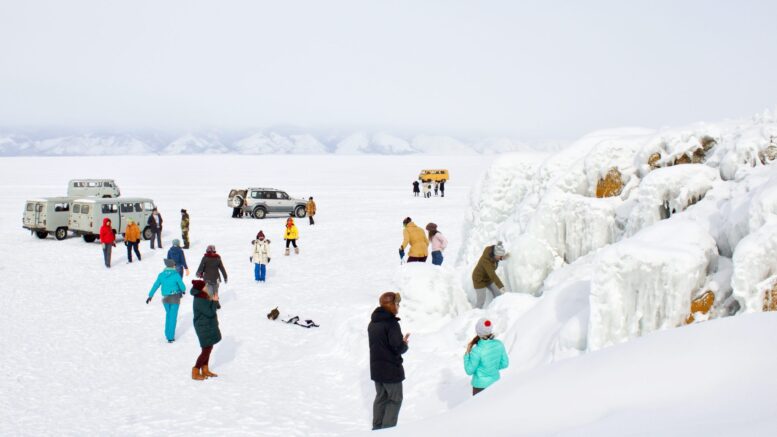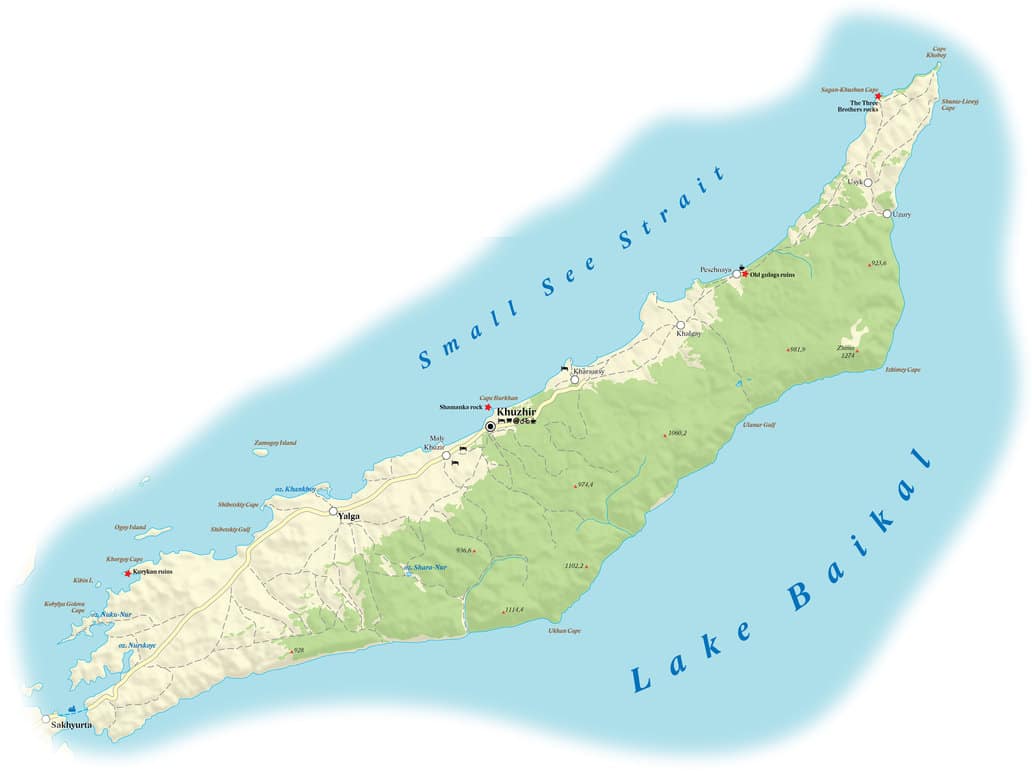Tourism in Russia today makes up approximately 16% of the nation’s economy; however, “ecotourism” comprises only about 1% of Russia’s tourism sector. Given that 65% of Russia’s diverse lands are wilderness and largely untouched by development, Russia is in a favorable position to significantly realize its ecotourism potential. Yet, in order to do so, such development must be implemented properly.
“Properly” for ecotourism means that travel to natural areas must respect and conserve the environment, sustain the well-being of the local people, and involve environmental education. This concept, however, has not yet developed in Russia; therefore, ecotourism must be implemented in a way which is environmentally and commercially sustainable.
This article will use the Island of Olkhon on Lake Baikal, in Russia’s Siberia, as a case study for how ecotourism is developing in Russia, where the sector shows great promise, but has yet to fully take hold in an economically and environmentally sustainable way. Baikal already has a world-wide reputation and is one of Russia’s fastest-growing ecotourism locations, but also stands at an uncertain crossroad, in which the future of its ecotourism depends on the foundations and precedents currently being created.
Ecotourism in the Baikal Region
Beginning in the 1980’s, environmentalists began promoting ecotourism as an alternative to standard commercial mass tourism. Russia was an early adopter of the concept. In the 1980’s, the Bureau of International Youth Tourism Sputnik Travel Company developed a number of trails to view the Goloustnaya River Valley in the Baikal region. These paths were coined “ecotourism routes,” due to the fact that their design left a minimal impact on the natural environment and those participating in the tour also learned about the environmental problems of Baikal.
While this may have been the first project to use the label “ecotourism,” it actually built off the region’s long-established national parks, the largest of which is Pribaikalsky, within which Olkhon Island lies, situated midway up Lake Baikal, separated from the lake’s western shore by the Straits of Olkhon and Maloye More (Little Sea). The combination of a dry, hot climate with strong winds gives rise to a unique aeolian terrain and the formation of desertificated-steppe and forest-steppe ecosystems, which are home to 135 species of birds, and 20 species of mammals, including the Olkhon vole, 3 reptile species, and 1 species of amphibians, dozens of which are endangered or regionally endemic.
The island also along contains numerous natural monuments, as well as 143 archaeological monuments, including rock carvings, ancient settlements, and burial sites, originating from the longstanding presence of Shamanist and Buddhist traditions there.

The island’s main settlement, Khuzhir. Photo taken by Rylin McGee.
Today the island is inhabited by only about 1500 people, 1200 of which live in the island’s main settlement, Khuzhir. The island, however, is seeing increasing numbers of tourists – growing from 50,000 people in 2000 to 250,000 in 2004. After electricity was permanently installed on the island in 2006, these numbers continued to surge – up to 530,000 thousand in 2012 and 1.4 million in 2014.
However, in 2015, environmental researchers E.A Ponomarenko and C.V. Solodyankina found that the maximum capacity of visitors to the island during the summer season, given the current infrastructure, should not exceed 33,400 persons, in order to preserve the ecological character and health of the island’s ecosystem. Yet, as statistics show, such figures are much larger, reaching over one million, with far-reaching effects.
A strategy for handling the growing tourist population must be developed in order to protect the local environment, culture, and population’s livelihood. The implementation of ecotourism on Olkhon is a viable option; however, there are a variety of economic and environmental aspects which must be considered to ensure successful implementation and development.
Infrastructural Constraints on Olkhon Ecotourism
Prior to Olkhon’s tourist boom, the island lacked many forms of basic infrastructure. With growing tourist numbers, this is changing. In 2005, the island connected the mainline grid brining a continuous supply of electricity – before this, the island used a single diesel generator. Yet, to promote sustainable travel and protect Olkhon’s environment, many more infrastructural issues must be addressed.

In 2005, Olkhon connected to the mainline grid, bringing electricity and cellphone connection to the island. Photo taken by Rylin McGee.
-
Transportation
Transportation has long been a major issue on the island. First, as there is no bridge to Olkhon, cars must use a ferry system that currently has the capacity to transport only 9-10 cars at once. During the busy season, queues form that can last for days. Helicopters and private boat transfers have developed to compensate for this for higher-end tourists, but most tourists do not choose to partake in them. While this issue is alleviated during the cold months, when the lake is frozen, most visitors, of course, come in the warm summer months.

Undeveloped roads on Olkhon, photo taken through the windshield of an all terrain vehicle by Rylin McGee.
Further, roads on and surrounding Olkhon are mostly limited to dirt roads or rough paths. This limits access to the northern half of the island to those with all-terrain vehicles and the knowledge of how to use them. Better infrastructure will be needed to open this half of the island to wider tourist access.
Additionally, the island lacks a space for automobile parks, suitable tent sites, and delineated tour paths, causing most visitors to simply create their own. As a result, the vegetation and ground cover surrounding popular tourist locations erodes while waste from tourists and exhaust from uncontrolled motor transport has further detrimental effects on the local environment.
While such issues could be alleviated with the development of roads to popular tourist destinations, their placement must be carefully considered, as the problem of habitat corridors can arise, in which a habitat connecting wildlife populations is separated by human activities or structures, resulting in population isolation and reduced genetic diversity.
-
Housing
As of 2015, there were 22 tourist facilities on the Island, mostly concentrated in the village of Khuzhir. These can house about 1200 people at any given time – about the same number of people as actually live in Khuzhir. In the same year, an estimated 1.4 million tourists visited the island – at least 3x the island’s current annual housing capacity. Many tourists thus come on day trips and many choose to camp outside of designated facilities.
While hotel services are expanding, in 2017 an audit of facilities being developed found that many buildings intended as tourist facilities were actually registered as private constructions or even subsidiary farms, meaning that they would not be able to legally function as tourist facilities upon completion. Of primary concern in this matter is the issue of groundwater abstraction licences as well as the systems developed for waste collection for these new facilities.
-
Waste Management
Perhaps of greatest concern, the island still lacks proper water, sewage, and waste collection networks. Water is often imported to the island by trucks and collected in tanks or wells. Most hotels and recreation centers are equipped at best with leaking cesspools or outhouse latrines, discharging sewage directly into the ground, despite the fact that a water protection zone exists.

Unregulated waste disposal in the forest near Khuzhir.
Most of the waste generated on Olkhon is imported from vacationers, or to serve tourist purposes. Frequently, the waste ends up both on the shores of the island, where tourists commonly visit, as well as within the villages. Wind then carried the waste throughout the entire island and into Lake Baikal, creating both chemical and biological environmental risks for the island and surrounding area.
-
Human Resources
Lastly, as Okholon Island is a traditionally poor and secluded area, many locals do not have strong experience with international tourism standards, much less training in foreign languages and cultures. Many foreign companies, particularly Chinese, often bring many of their own service providers on group tours to the island, which means that locals do not profit from the industry as much as they could. Likely, the island could benefit from professional training and education to reach a wider market with local talent.
Additionally, the island could benefit from environmental education services. Common challenges associated with tourism on Olkhon include raiding local forests for firewood and brush collection, overfishing, and the introduction of domestic pets to the island. While seemingly nominal, these activities have the potential to significantly alter Olkhon’s ecological balance, when carried out on a large scale, and thus will require consideration in order to develop tourism in an ecological manner.
While there is a lot of room for the improvement of infrastructure, the development of this infrastructure itself must be carefully undertaken, so as to minimally impact the island’s undeveloped nature, which is a primary reason that so many tourists come in the first place.

Olkhon and frozen Baikal. Photo taken by Rylin McGee.
Impacts on Olkhon Island’s Local Population
Another aspect of ecotourism development is the opportunity to raise the socio-cultural morale of the residents of Olkhon. Ecotourism is commonly cited as creating social and personal purpose for individuals involved in the services, because of its positive impact on employment and income levels, developing useful municipal infrastructure, as well as the incentive it provides for locals to revive and display traditional forms of life and cultural practices.
Olkhon’s rich history of Buryat, Buddhist, and Shaminist tradition, can be seen in the island’s architecture, religious and historical sites, and legends. For many tourists, this history generates curiosity and interest. However, tourism can also play a negative role in the commercialization of culture and tradition, in which the benefits of traditional cultural practices become oriented towards tourists, rather than maintaining their original meaning to the locals.

Tourists are also drawn to the island due to its rich cultural history, which can be seen in these wooden totems of Shamanist tradition. Photo taken by Rylin McGee.
Development Opportunities for Ecotourism in Olkhon
Thus, growing interest in Olkhon as a travel destination provides the opportunity to expand tourist services, improve local infrastructure, and celebrate socio-cultural tradition. However, effective policies are going to need to be implemented if tourism is to remain a sustainable industry on Olkhon.
In this, utilizing the concepts of ecotourism can be helpful – not only in creating controlled tourist zones, but especially in integrating tourist education – to prevent habitat destruction.
This education should begin with how the island is marketed. For instance, domestic tourism to Olkhon increased after 2014, after the depreciation of the national currency and bankruptcy of several large tour operators resulted in fewer Russians traveling abroad. Olkhon was then marketed an inexpensive opportunity for holiday vacation, leading many to see it as a cheaper replacement for the sunny resorts of Turkey or Egypt. However, those resorts of course have more infrastructure to support commercial tourism, which often arrives assuming certain levels of service and support. In this area, Olkhon, with its sunny beaches, is certainly not equivalent to an international resort.

Many residents offer their own tourist services, including hotels, cafes, and eco-tours. Photo taken by Rylin McGee
Because many tourists arrive driven by cost incentives and ignorant of the environmental concerns of the region, many instead contribute to local environmental problems. Marketing the island specifically as a rustic, ecotourist destination – one with limitations but also local educational opportunities – would provide incentive to engage in eco-friendly practices from the outset.
For visitors to Olkhon, the primary recreational activities include participating in walking and driving tours, viewing natural and cultural sites, building campfires, camping, and fishing. In creating controlled tourist zones, these activities should be taken into account so as to utilize the existing development of ecotourism on the island, while improving its sustainability.
Some steps have been made to improve needed infrastructure on the island. In November 2016, a presidential grant was awarded to New Generation, a local organization, along with the Olkhon Coordination Council to create a fund for development on the island. The goals for the grant include further developing civil society, ecological and socio-cultural spaces, while also improving the quality of life of for the local population on Olkhon.
As a result, several sustainability projects were proposed and are currently underway. These include the creation of a pedestrian hiking trail and eco-greenhouse, the promotion of cultural souvenirs and local music, and the distribution of locally sewn canvas bags, meant to be used while on the island and left to be reused after departure. In addition, a series of 25 garbage containers were installed on the island, with compartments for plastic, glass, and garbage. In the 2017 season, 15 tons of glass, 3 tons of plastic, and more than 100 cubic meters of other garage were collected by these containers (but that’s still a fraction of the garbage created on the island). The organization also helped establish a series of lectures on clean building materials, alternative energy installations, ecological transport, environmentally friendly food, and issues of organic waste and domestic sewage.

Newly created garbage and recycling containers, found in Khuzhir. Photo taken by Rylin McGee.
With continued funding and support from the federal government, local Olkhon activists have the potential to successfully promote ecotourism and local sustainability on island. However, such efforts must match the scale and speed of growing tourist interests, as well as ensure infrastructure and development frameworks are implemented to protect the island’s unique ecosystem and culture.




